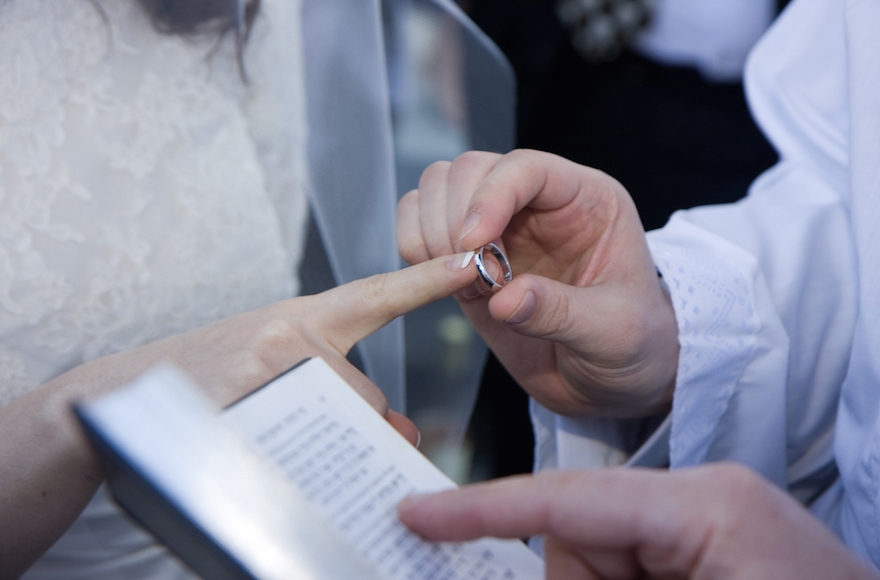NEW YORK (JTA) — The text was a bit wordy, the content a little humorous, and it took weeks of brainstorming and creative writing. But when Robin Weber finally finished writing her own ketubah, the Jewish marriage contract was everything she wanted it to be.
The final version included generic lines about promising to love and respect her husband, Ben, as well as more specific ones like this: “Sex will always hold a place of honor and importance in our relationship.”
And this: “Ben gets to look at Robin, realize how beautiful she is, smile, and she may not smirk.”
And noting the couple’s enthusiasm for firearms — their wedding reception featured a shooting range with semi-automatic weapons — Weber added this: “Both parties agree to keep their marksmanship up to par. Should either party fail in this regard, the other is entitled to twenty goats.”
Weber, a 42-year-old Reform Jew from central Vermont, is among a number of Jewish women from across the denominational spectrum who are pioneering new ways to make their Jewish weddings more egalitarian and reflective of their individual tastes and personalities. Many of the changes reflect a desire to introduce more gender neutrality into the wedding by drafting ketubahs that establish women as more equal contractual partners and giving them a more active role in the ceremony.
“I kept finding a lot of text that just didn’t seem meaningful to women,” Weber told JTA. “There was all this talk about sexual satisfaction and a man’s obligation to support the wife, but nothing which personally reflected how I wanted my relationship to stand.”
Anna Abramzon, a graphic designer from Texas specializing in ketubuahs, wrote in an email that some clients use traditional ketubahs “and tweak with them just a little, like adding their mother’s name to the text.”
“But more than half my clients choose to go on a different route, writing their own to focus on building a life, future, and home together,” she wrote.
Sharon Adhout, a Conservative Jew from Detroit, opted to rewrite the sheva brachot, the seven blessings recited at a wedding. She conceived of the idea after some college friends suggested that women needed to have more of a voice.
“If my wedding ceremony was supposed to reflect my husband and me, and suggest an idea of the good thoughts my guests’ karma should bring during the ceremony, why would I read blessings written by someone else?” Adhout said. “Honestly, writing new blessings caused some tension with my parents, who tend to be more traditional, but it was the right decision in the end.”
Though issues of gender equality tend to be taken more seriously in the liberal denominations, Orthodox women also are pushing for more inclusivity.
Yehuda Sarna, an Orthodox rabbi at New York University’s Bronfman Center for Jewish Student Life, said he’s seen a rise in the number of Orthodox couples who want to make their ceremony more egalitarian. Within the boundaries of Orthodox law, he tries to accommodate them.
“Adding egalitarian customs to the wedding within the confines of the law gives women a sense of ownership and enables them to have a sense of connection to the wedding,” he said. “Within Orthodox halachah, women cannot serve as witnesses for some ritual aspects of the ceremony, but they can play other important ceremonial roles. It’s important as they grow as individuals and as a couple.”
Jordanna Birnbaum, a 25-year-old NYU alumnus from Long Island whose wedding was officiated by Sarna, opted to have an all-woman’s tish, a custom traditionally practiced by men. She also had a woman speak at her ceremony, which concluded with the singing of “Jerusalem of Gold,” which was written by the famed Israeli female songwriter Naomi Shemer.
“Within the Orthodox community, I felt that the bride often takes a passive role,” Birnbaum said. “I wanted to keep the ceremony within the framework of traditional Jewish law while creating an inclusive and egalitarian ceremony.”
Many trace the roots of gender sensitivity in Orthodox weddings to a 2003 essay by Dov Linzer, the head of the liberal Yeshivat Chovevei Torah Rabbinical School in New York, in which he suggested various ways women could become more involved in their weddings.
Linzer suggested three innovations: having the bride recite a verbal acceptance after receiving the ring from the groom; having the bride deliver a ring to the groom under the huppah immediately after signing the ketubah; and having women read an English translation of the sheva brachot.
He said a growing number of couples have adapted these suggestions over the years and often call him for guidance in these areas.
“We’ve reached a point where women and men want their wedding ceremony to be one of greater parity and more true to their understanding of their marriage,” Linzer said. “This is about being true to themselves and their understanding of their marriage coupled with their commitment to tradition and halachah.”
JTA has documented Jewish history in real-time for over a century. Keep our journalism strong by joining us in supporting independent, award-winning reporting.






